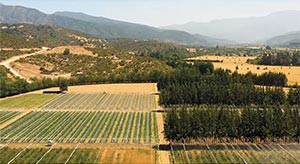Blockchain is the tracking method preferred by industry right now
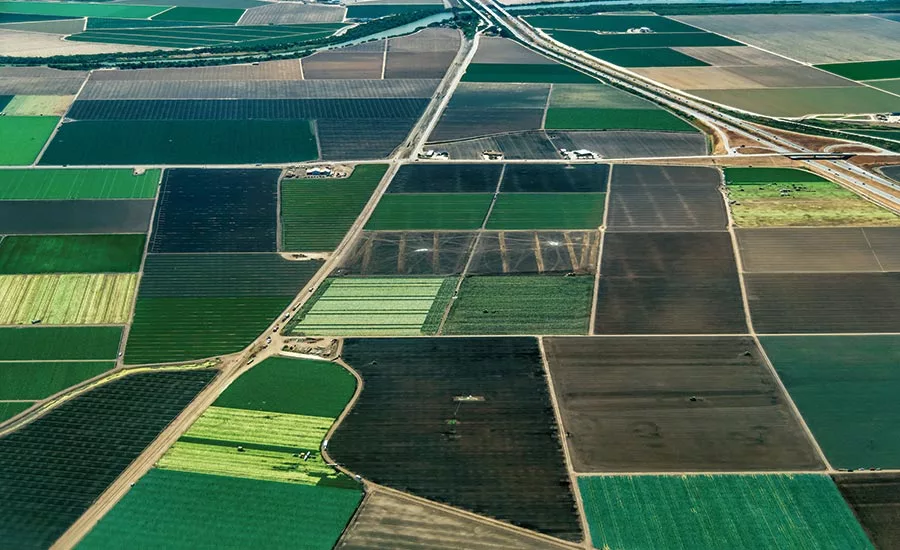
Blockchain advocates say it can help us figure out almost instantly which shipment, processing plant and field our food came from. Blockchain isn’t the only tracking method, but it’s the one with momentum in the industry right now.
Photo courtesy of Getty Images
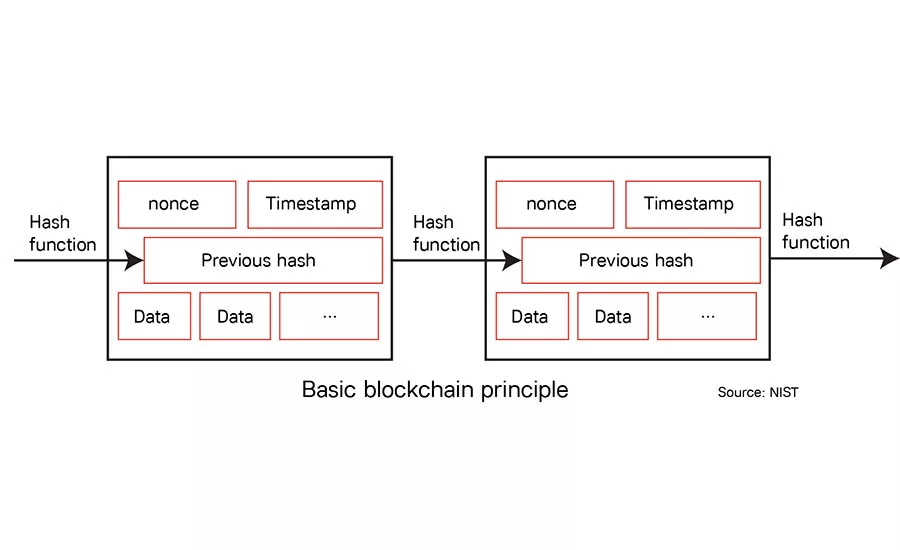
A blockchain is a distributed database that links blocks of data and is operated by a network of anonymous peers. These blocks are timestamped and stored in a linear and chronological order. Each block contains a set of data, a timestamp and a hash of the previous block. A two-step validation process consists of validating the data inside the block, then all peers agree on the previous validated data.
Photo courtesy of National Institute of Standards and Technology

An ERP supplier, IFS, looks at basic blockchain advantages and disadvantages for track and trace.
Photo courtesy of IFS
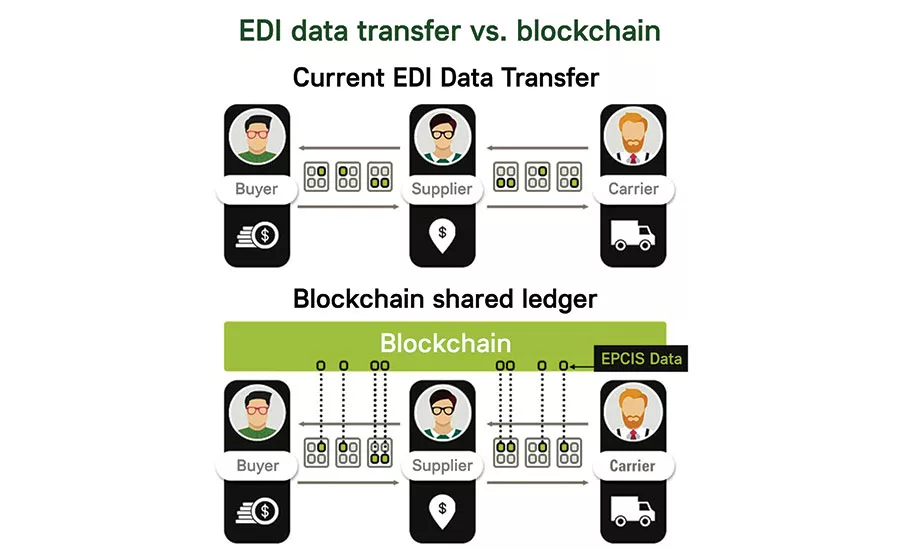
This graph compares data flow between a conventional EDI transfer and EPCIS blockchain transfer.
Photo courtesy of CAT Squared
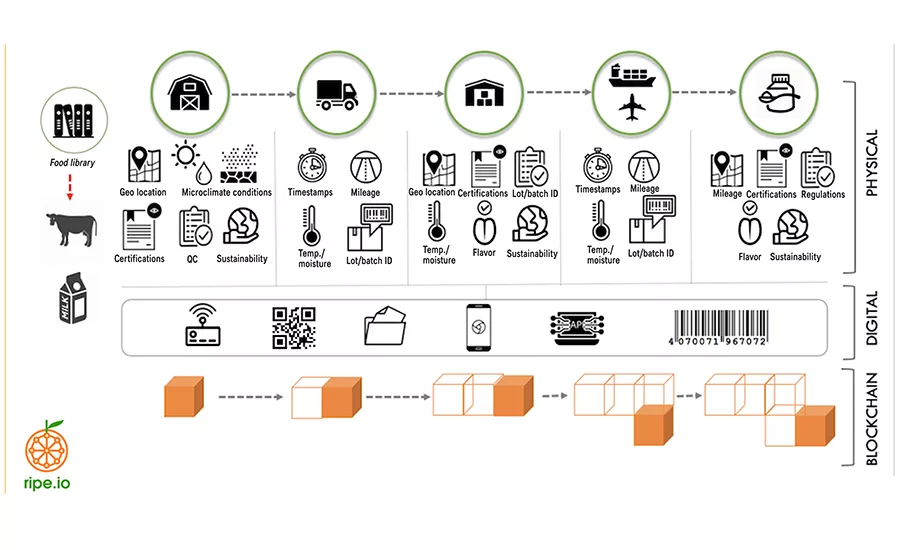
Blockchain technology has the ability to capture and retain all pertinent data from the farm, through processing and storage/transportation to ultimately the consumer, and specialized blockchain providers such as ripe.io have answered the call, focusing on regulated industries such as food and beverage.
Photo courtesy of ripe.io
If you’ve been in operations and using technology for some time, you may remember the hoopla when the Windows 3.0 OS came on the scene. You probably had been living in a world where the very stable UNIX OS and Oracle or IBM databases were the main underlying system technologies, and real-time operating systems with deterministic networks were the norm for process control. At that time, Windows 3.0 (built on DOS with networking as an afterthought) and Ethernet were not serious considerations for the plant floor.
Blockchain is like one of those underlying technologies. While it’s relatively new, there’s also been a lot of hype about it—in fact, it uses networking and distributed database technology with encryption, security and much more. But should you jump on the bandwagon now? Just how integrated is blockchain technology with applications? Is one blockchain compatible with another? Is it secure? Should you wait until the dust settles out?
It’s probably safe to say that in a few short years, blockchain technologies—the basis for crypto currencies like bitcoin—will most likely become one of those assumed back-end technologies that will support applications like ERP, MES, track and trace, supply chain, food safety, and so on. You can imagine hearing at a tradeshow, “Of course, our MES, ERP or supply chain management system supports (or runs on) blockchain technology.” In fact, some providers are already marketing blockchain as a service (BaaS).
Originally, blockchain technology applied to the food and beverage supply chain got its send-off with IBM and Walmart working together to improve track and trace capabilities. In a famous test, doing a traceback with a conventional system took almost seven days, reduced to a couple of seconds using IBM blockchain technology. (For more information, see “Blockchain technology a solution for supply chain traceback issues,” FE, Feb. 12, 2018.) Since then, IBM has set up the IBM Food Trust, which makes use of blockchain technologies.
I spoke with software and system developers, ERP and MES providers, and other application providers to get a pulse on blockchain technologies and a sense of direction of what’s available now and what we might expect in the future. From the responses I received, not all suppliers are sold on committing to a blockchain-only solution, but have given users the option to connect to blockchains externally or take advantage of integrated blockchain technology if they desire.
Where are we now?
“Blockchain is a form of unique distributed ledger technology (DLT) that is shared between independent computers,” says Jonathan Wilkins, EU Automation marketing director. “The DLT holds time-stamped, unchangeable records, which cannot be altered unless they’re agreed by all other supply chain users, which prevents records from being tampered with.”
“For blockchain to succeed in manufacturing supply chains, all raw materials, components, sub-assemblies and production actions must be recorded as transactions or events on the blockchain digital ledger,” says Joe Whyte, Rockwell Automation global enterprise account team lead.
Blockchain provides a “single version of truth” to all authorized supply chain participants, says Whyte. With blockchain, raw material producers and product manufacturers can prove the origin and quality of their products, while all supply chain logistics vendors and retailers can be certain of the products they handle and deliver to customers or consumers.
Even with the success of the IBM blockchain solution noted above, there have been detractors who say it technically isn’t a blockchain because IBM’s Hyperledger Fabric doesn’t require a true consensus mechanism at all. (See the article “IBM’s Hyperledger isn’t a real blockchain—here’s why,” by Stuart Popejoy, cofounder and president of blockchain startup Kadena. The author has 15 years experience in building trading systems and exchange backbones for the financial industry.) Popejoy suggests that without enforced, democratized, cryptographically-secure voting between participants, you can’t really prove whether an agent tampers with the ledger.
Whether or not IBM’s blockchain technology meets a specific criterion, blockchain-based technologies, according to Wilkins, can assist with food traceability initiatives in six key areas. They include food safety and recalls, food fraud, regulatory compliance, social issues, sustainability and consumer information.
Meanwhile, NIST has been working on securing blockchain systems from digital threats and on a set of standards to define how blockchain technologies should work in manufacturing. See “Extending the applications of blockchain in the food manufacturing industry,” FE, April 15, 2019.
When it comes to the food and beverage industry, DLT can assist with providing a decentralized platform that allows vendors and consumers literally to track their products from farm to table, and ensure the quality and safety of their food, says Kris Sibley, director of sales for food, beverage and agriculture solutions for Chetu, a custom software solutions and IT services provider. DLT involves the integration of technology at every level of production that provides traceable, time-stamped records of the movement of goods, and would drastically improve food recall processes should an issue occur.
In November 2019, CAT Squared became the first MES provider in the food industry to become an onboarding partner for IBM Food Trust, a blockchain-enabled global network of food chain participants that securely connect supply chain data across the ecosystem with trust and transparency, says Kathy Barbeire, CAT Squared marketing manager. (See “CAT Squared becomes IBM Food Trust onboarding partner,” FE, Nov. 12, 2019.)
“To help our manufacturing customers build trust and transparency with consumers, we’ve begun developing CAT2 FoodTrace, a blockchain-enabled traceability platform that will allow manufacturers to make available varying levels of traceability data to other supply-chain stakeholders,” says Barbeire. FoodTrace’s levels of visibility include a manufacturer, retail and consumer portal—each with its own levels of visibility.ERP, track and trace, and blockchain
Blockchain’s integration with ERP systems is essential for the widespread growth of the solution, and it’s becoming an instrumental part of many businesses’ software suites and IT roadmaps, says Chetu’s Sibley. Blockchain’s ability to create easy-to-identify information chains that cannot be manipulated makes it the perfect complementary solution to numerous systems in the food and beverage industry, such as food safety, quality management and supply chain systems.
ERP systems—especially those in the food industry—have long been known for traceability, even before the emergence of blockchain technology. “At IFS we have developed supporting capability for blockchain, but it is not deployed into the food and beverage sector as our ERP product, IFS Applications, already provides full end-to-end traceability without having to include additional blockchain overhead and complexity,” says Colin Elkins, IFS global industry director, process manufacturing.
Though not an ERP system, TraceGains is capable of tracking any food product from field to retailer in a matter of seconds. Is it based on blockchain? “Our customers have full ownership of their data,” says Marc Simony, head of product strategy. “Through our API, they have the ability to join any blockchain initiative of their choosing.” (See how TraceGains helped a watermelon producer with traceability, FE, June 2, 2009.)
Due to increasing consumer demand, ERP software will need to be integrated to blockchain to access supply chain data and develop an electronic system of record for any company, says Joe Scioscia, vice president of sales at VAI. In the food and beverage industry, tracking has become increasingly essential to all parts of the supply chain to comply with food safety regulations. Blockchain has emerged as a potential solution to improve the industry’s tracking capabilities, not to mention it can create an electronic record of ingredients, expiration dates, temperature controls and more—all vital to reducing food safety risks.
“As a cloud-based ERP solution provider, VAI offers applications for customers (including track and trace, supply and demand planning, route management) that can integrate blockchain with our ERP system and help with food safety compliance or any other type of blockchain that arises in the future,” adds Scioscia.
OPTEL Group is a traceability company that provides farm-to-consumer, product-based digital traceability solutions for the food and beverage industry. OPTEL has expertise in deploying traceability in remote farmlands, as well as being able to track and trace products from the production plant to the end consumer, says Vanessa Grondin, global head of strategy, food and beverage. The data is typically stored in a cloud database. “We store transactional events as well as relevant information related to a given product or an event. Blockchain is another type of database that is best used for storing transaction of events. Our traceability transactions can be stored in a blockchain if asked by a retailer or client,” says Grondin.
Cloud and blockchain go hand-in-hand when it comes to SAP ERP products. “At SAP, we’re constantly infusing blockchain into our product portfolio, especially in decentralizing business workers and enabling cross-company business processes,” says Richard Howells, vice president of solution management for digital supply chain. SAP Cloud Platform Blockchain services are generally available, and our blockchain-as-a-service offering makes both Hyperledger Fabric and Multichain blockchain technology actionable—meaning that users can extend existing solutions with enterprise blockchain capabilities, build their own enterprise blockchain-based application according to their specific needs, develop an enterprise blockchain network, and lay the foundation to participate in productive enterprise blockchain installations.” SAP’s intent is to use blockchain technology to empower food and beverage companies to tackle challenges or uncertainty commonly associated with blockchain and the food supply chain.
Another BaaS offering comes from Omnichain, which is intended to tame supply chain issues. Omnichain offers an end-to-end software platform that enables food and beverage manufacturers to establish their own blockchain network and distributed ledger of supply chain data—from farm to fork/cup, says Pratik Soni, founder and CEO. It’s a solution that is ready to deploy out of the box through a BaaS delivery model, which streamlines implementation time and costs. “From a single decentralized platform, our clients—along with the other stakeholders in their value chain—can obtain visibility into holistic supply chain data, improving transparency and accountability among all parties,” says Soni.
Ominchain’s BaaS, however, may be the first such system with AI capabilities. With distributed ledger as the foundational data layer, the solution offers food and beverage manufacturers more than insight into product provenance. Using the latest in artificial intelligence and machine learning, it can take all that supply chain data logged on the distributed ledger, run predictive analytics and deliver intelligent recommendations in how to hit targeted outcomes. These may be objectives like improving demand forecast accuracy, increasing supply chain efficiency, or reducing costs and waste. “Our clients are able to derive more value and execute on their data to simplify, orchestrate and automate their supply chains,” adds Soni.
Track and trace
Global supply chains today are incredibly difficult to track and trace, says Chetu’s Sibley. Even with the latest technology, paperwork trails are difficult to follow, don’t offer any transparency and can be manipulated by those who would adjust specific details of orders. Blockchain technology opens up everything and creates a linear, easier-to-follow trace on food products that cannot be altered. Besides providing the means to track products, blockchain technologies can show consumers where their food originated.
Right down to the animal, that is. Neogen, which does food safety and genomic testing, has partnered with Ripe Technology, a food and farm blockchain provider, to track the genomic profile of a dairy cow, the food it eats, its medical history, barn environment, and quantity and quality of the milk it produces. Though most consumers wouldn’t care about all that data, how the cow is cared for may influence their yogurt or cheese purchase.
“Neogen’s diagnostics and DNA expertise can add the highest degree of transparency and factual correctness for critical issues around authenticity and accuracy of food recalls,” says Raja Ramachandran, Ripe Technology’s CEO. “We believe this will change the game in food transparency for improved quality assessment from the beginning of the supply chain all the way to consumers.”
CAT Squared shows how blockchain works differently than the use of the common EDI (electronic data exchange). In the illustration, “EDI data transfer vs. blockchain,” the top graphic shows the current state of today’s supply chain using EDI. Messages are point-to-point, one-way communications. Each party has unique and limited visibility, and therefore, each has its own version of the truth.
The lower graphic shows how supply chain participants can contribute EPCIS (electronic product code information services) to a blockchain. Because the ledger is shared, data is transparent to all permissioned participants within the blockchain. And since the ledger is a type of database that only allows entries to be appended rather than changed or deleted, the data in the ledger is immutable, which means it’s unchangeable. And, because it’s stored in multiple locations, no one participant in the business network can modify the ledger without everyone knowing. This creates trust in the provenance of the ledger, or what blockchain providers call security through transparency, or trust through transparency.
Call me a worrywart, but while blockchain technology promises traceability and faithful reproduction of data, the ability to prove trustworthiness of data doesn’t necessarily prove the data is truthful. “The only issue with the technology is how to ensure the primary information put into the blockchain is trustworthy,” says EU Automation’s Wilkins. “In situations where the market is highly controlled, this will not be a problem, but it is the crux on which the technology will either thrive or die.”
“The main advantage of a blockchain is that it’s an immutable distributed ledger,” says Optel’s Grondin. This means registered events can’t be erased, and they’re visible to all who have permission. In the near future, smart contracts hold promise. However, for a blockchain solution to be useful, a company still needs to connect its IT systems to the blockchain solution—hence, the connectivity effort is mandatory.
But Grondin notes that if a company’s IT systems are connected to a cloud database, and that other stakeholders are also connected, the end result would be the same: visibility into the supply chain. Grondin also expects that the next frontier for supply chains is efficiency gain through the use of AI. However, she isn’t convinced that a blockchain database is the most efficient way to perform AI, compared to a cloud database.
Can blockchain data be deleted?
The short answer is no. “By design, data recorded on the blockchain is immutable,” says Omnichain’s Soni. “So, records can never be deleted. They may be updated. However, there will be a clear lineage showing what was changed, ensuring full transparency among stakeholders.”
It’s a type of database platform that only allows entries to be appended rather than changed or deleted, meaning that the data is immutable, says CAT Squared’s Barbeire. Think of it like a double-entry bookkeeping system. If an accountant makes a mistake in crediting or debiting an account, it can’t be “whited out.” Instead, corrections have to be made to the corresponding affected accounts.
It is possible to control who gets to see that information—even individual transactions—through permissions, adds Soni. Deciding what a user can access depends upon the person’s role and responsibility in the food value chain. An ingredient supplier, for example, likely won’t need insight into sales performance further down the road. Likewise, a grocer probably won’t need to know crop yield among farmers upstream in the supply chain.
With regard to who can see what information, it really depends on what kind of blockchain is being used, e.g., public or private, and open or closed system, says Chetu’s Sibley. Private and public refers to who is able to write data onto the blockchain, versus open and closed, which is viewable or not.
Blockchain—as an unalterable, peer-to-peer recordkeeping system—can reduce the amount of paperwork across the supply chain as manufacturers can convert important documents, such as legal papers that could be lost when exchanged between companies, to simple, automated files, says EU Automation’s Wilkins. Blockchain can create a smarter, more secure supply chain because it provides a solid trail that is visible in real time.
It’s important to remember, however, immutable data isn’t necessarily 100% safe, if security is not practiced, says TraceGains’ Simony.
Theoretically, blockchains are tamperproof as they use a cryptographic fingerprint that is unique to every block in the chain, and every computer in the network agrees on the shared history of the transaction, says Sibley. Where hacking is possible, however, is infrastructure outside this network not fully subject to the same protocols as the blockchain?
Can blockchain prevent food fraud?
Food fraud, or the intentional tampering with food products for financial gain, costs the global economy over $30 billion annually, says Sibley. Besides outright criminal fraud, blockchain technologies can be used to show that animals were treated humanely on the farm and that farmers received a fair price for their products, two issues that can affect the buying decision for many consumers.
Blockchain may not always prevent food fraud because humans still work in the supply chain. For example, there are still many data gaps along the supply chain where trade partners rely heavily on paper-based transactions, says Barbeire. This allows records to be lost, unreconciled and remain invisible to the rest of the supply chain. By shipping IIoT devices like tracking sensors with goods, data can be collected and contributed to a blockchain along the supply chain, giving trade partners visibility to a shipment’s location, temperature, humidity and other quality data.
IIoT sensors definitely can help, says Sibley. Consider a producer of a soft beverage purchasing sugar from a supplier to add to the product. The company, along with others along the supply chain, could leverage IIoT-integrated sensors to ensure that the sugar product is pure—not cut with anything—and packaged in the proper amount prior to purchase and transit. The IIoT sensor would work with the smart contract functionality of blockchain to release funds upon completion of the contract.
Additionally, the introduction of smart contracts would save companies money and reduce the need for third-party regulators, such as traditional banks, to ensure the smooth transition of funds. Lastly, should any partner be found to break the contract agreements, blockchain solutions can quickly determine where the fault lies and provide a record for proof of breach of contract. Consider this a great digital safety net for companies doing business on an international scale.
Ominchain’s Soni describes another example. If a supplier in China ships a crate of conventional soybeans to the United States, and someone in the middle of the transport process tries to misleadingly mark them as organic, parties on the receiving end could reference the original dispatch record and immediately catch the fraud attempt. At the same time, a manufacturer whose selling point is that its products are organic, kosher or GMO-free can look back at the ingredients and production processes to validate that they meet these standards.
“In the food and beverage industries, we are seeing an increased demand for local and organic products with a clear proof of origin and sustainability to avoid food fraud,” says SAP’s Howells. Companies are leveraging blockchain to track products through the supply chain and provide consumers an app to tell them where a product came from and its journey from source to store. This helps food and beverage companies uphold the integrity of their products and prevent food fraud. Thus, producers can pinpoint the source of tainted food incidents swiftly to adjust the supply chain and move forward with production, eliminating possible contamination sources.
“Fraud is by definition the falsification of information, so I cannot see how blockchain could stop a manufacturer from deliberately committing a fraudulent act like declaring false information on a label or using an alternate cheaper ingredient—all these physical acts can be disconnected from the data being provided,” says IFS’ Elkins. “However, blockchain could help police and provide tracking and certification. It could also provide a greater level of transparency of certification within the industry.”
For more information:
CAT Squared, www.catsquared.com
Chetu, www.chetu.com
EU Automation, www.euautomation.com
IFS, www.ifs.com/us
Omnichain, www.omnichains.com
Optel Group, Food & Beverage, www.optelgroup.com/food-and-beverage
Rockwell Automation, www.rockwellautomation.com
Ripe Technology, www.ripe.io
SAP, www.sap.com
TraceGains, www.tracegains.com
VAI, www.vai.net
Looking for a reprint of this article?
From high-res PDFs to custom plaques, order your copy today!
